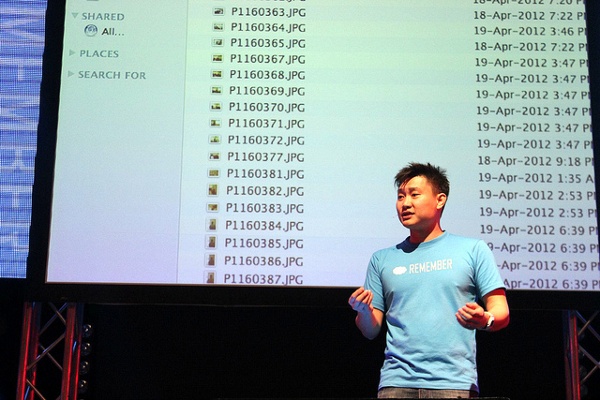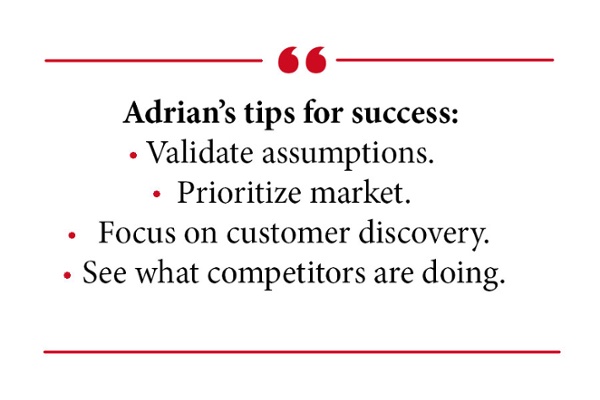Adrian Tan used to spend his days teaching kids what he knows about technology and researching new cool things to tell them. Then came a milestone – fatherhood. It wasn’t enough for this former teacher to document special moments by taking pictures. Those photographs, increasing by dozens each week, were stagnating in his phone. He thought about building a safe and secure platform that makes sharing and uploading pictures seamless.

Adrian pitching at the very first Demo Day of our JFDI 2012A Accelerate Bootcamp.
That idea was the reason he founded the startup Remember. The goal was to make an app that would capture, curate and organize memories of children for parents. As a self-starter going through the parenthood journey, Adrian told himself, “There must be a better way.”
In 2012, his plans got in motion. He reached out to two friends in Hackerspace Singapore to help him. In the second quarter of the year, Adrian and two of his technical co-founders, Luther Goh and Ruiwen Chua started working on delivering the app.
Adrian describes the experience: “Starting up, you will learn to kill your addiction to your monthly paycheck. You will learn to live lean.” He said life in a startup is an emotional rollercoaster. “High one day, and next day in the trough of sorrow. Finding a balance was essential,” Adrian adds. With three qualified founders and a viable idea in tow, the team enrolled in JFDI Asia’s first-ever Accelerate 2012A Batch.
Accelerators are programs in which nascent ventures enroll in limited duration–usually three months–and either quickly grow or fail soon after. Sadly, within the year of starting up, Remember had to shut down.

Failure will always be a combination of many factors, but in hindsight Adrian sees the picture much clearer. He cites lacking focus in customer delivery as one of the reasons. In Aparna Shanker’s post entitled, “What is customer value and how do you deliver it?” the author defines the many facets of customer delivery.
Shanker explains, “customer delivery means delivering value along the dimensions that matter most to its customers.” An example from the website adds, “From a customer’s perspective, the value of a cup of coffee enjoyed with a friend at a coffee shop might be greater than the value of a take-out cup of coffee. While the monetary cost of the cup of coffee in both cases might be the same, the value the customer extracts is different.”
Adrian’s team failed to prioritize the customer market. They overlooked the fact that parents are satisfied with Facebook. They didn’t care much for secure and private upload and sharing – they just wanted something fast and basic. To put simply, there was no market for Remember.
Another shortcoming that caused Remember to fail was that the founders didn’t look at what other competitors were doing. Turns out, there were myriads of other photo-uploading sites like Pic plum and Kid Capsule, trying to do the same. Some were better funded. Sony even had their own, Million Moments. Clouded by the excitement of delivering the app, the Remember founders failed to validate assumptions before building.
The team failed to raise investment as the big boys launched features that help consumer backup their photos, such as Picasa, Dropbox, and Apple’s photostream. In addition to lacking customer discovery and failing to validate assumptions, Remember had a faulty business model. Were they a feature or a business? Features get disrupted by the big guns every conference.

“Failure was hard, it will always be,” Adrian says. “If I were to do it again, I will devote all the time to customer discovery and to validate my assumptionsfirst before building anything. This gives clarity to direction with a data driven approach, helps with UX and saves you money, time and sleep.” As what an effective individual would do, Adrian pivoted to using this experience and teach others what he learned. Today, he is JFDI’s Lean Startup Coach, a role that helps early-stage startups with their business ideas. His job now, Adrian says, “helps prevent entrepreneurs from building something people don’t want.”
—-
 Crystal Neri writes content and handles social media at JFDI Asia. Say Hi to her on Twitter, @nericrystal.
Crystal Neri writes content and handles social media at JFDI Asia. Say Hi to her on Twitter, @nericrystal.



Hey Crystal, This is a fantastic article — would we be able to re-publish it onto e27.co? We’ll link back to the JFDI blog of course. Let me know via email, thanks!